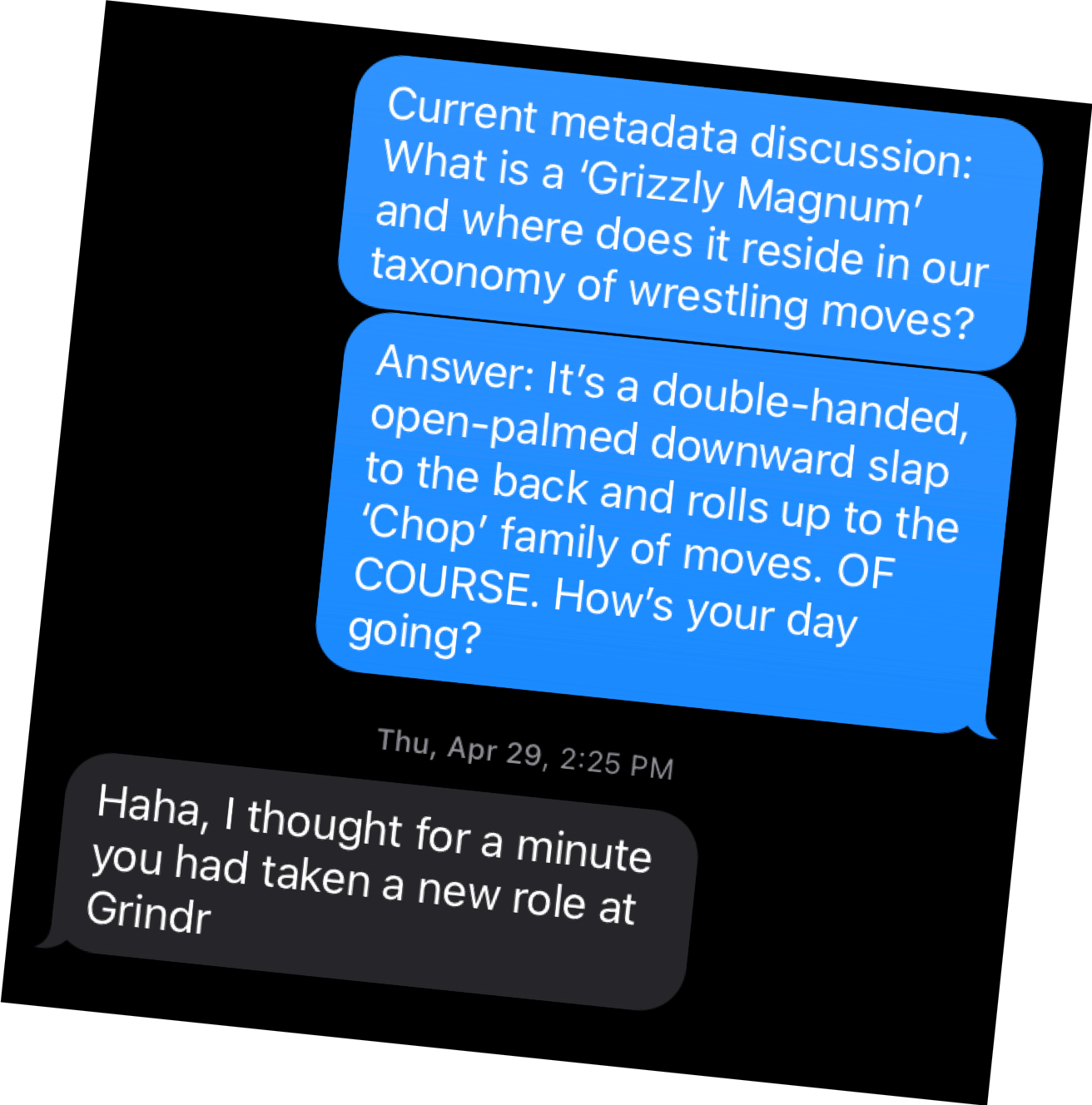On Naming Conventions
Your team's naming conventions and nomenclature form a language. How easy have you made that language to learn?
Thanks for reading Oscillations - a newsletter where I look for lessons in growth from all aspects of work & life, making them applicable to all areas of work & life. Why’s it called ‘oscillations’? I explain it here.
⛵️ I once borrowed a boat (a 470) with a friend of mine (the guy with whom I sailed THIS RACE) to go and race against the world’s best Olympic sailors for a few days. The event threw up the full range of conditions, everything from calm and fog to flat-out heavy airs and massive waves and I have never hurt all over in the same way as I did after that week.
We had many odd moments, but oddest of all was when, during a frenetic mark rounding, we turned a corner with boats tightly packed all around us, hoisting their spinnakers, and Conor shouted, at the absolute top of his lungs, this unexpected phrase:
🦷 TOOTHBRUSH! TOOTHBRUSH! TOOTHBRUSH! 🦷
Weird as it was, from that one word I knew what he was talking about and acted immediately, but the crews all around us looked at us, baffled. It’s a rare thing to stop a crowd of focused professional sailors dead in their tracks mid-race. Distracting them momentarily probably gained us a boatlength or two (which we promptly lost). So why did he shout that?
💳 The boat we had borrowed had some quirky ‘customizations’ toward the front end. A credit card had been cut in two, half of each half glued to the foredeck of the boat, with the free half of each credit card bent upward. The purpose? To catch the spinnaker sheets and stop them from falling off the deck and dragging in the water, slowing us down. The other weird customization was the heads of two toothbrushes, epoxy-glued by the neck, bristles-down on the deck, near the spinnaker bag. You could hook the spinnaker halyard (the rope that pulls it up the mast) underneath the bristles, thereby preventing the spinnaker blowing out of the bag accidentally.
When it was time to hoist the spinnaker, you had to yank that rope free from under the toothbrush – but sometimes that didn’t work at first attempt. When Conor went to hoist the spinnaker on this occasion, he could see that was the problem, and vocalized it so that I would know immediately what to do, hence TOOTHBRUSH, TOOTHBRUSH, TOOTHBRUSH.
An odd scenario, but an example of perfect, economical communication. Conor shouted one word, we shared a perfect understanding of what that word meant, and in the context of that scenario, I could take prompt action. No explaining, no additional comms needed.
Where to apply this in a work sphere? Anywhere where it’s beneficial for everyone to have a shared understanding of nomenclature. So, basically, everywhere. Let me explain.
MAINTAIN A SHARED LANGUAGE GLOSSARY
The quicker we get to a shared understanding of language within groups or teams, the quicker we reach efficiency in how we work and communicate. The sooner we stop having to explain things, the sooner we dispense with wasted time before action can be taken. Ensuring that you and your team have a shared language is critical for removing friction.
Often, jargon or shared language evolves within silos. When I joined WWE, for example, I’d hear words used, but there wasn’t a clear obvious meaning to them, so I started keeping a personal glossary to explore, adding to it daily. What’s KNOTTS? What’s a ‘Go-Home Week’? What’s ‘Omneon’? I’d ask around and sometimes get a bunch of different definitions for the same word, OR, I’d get different words used to describe the same thing, or, worst of all, realise plenty of people had been too afraid to ask and shared my lack of clarity.
🚪At CBS News, the homepage to CBSNews.com was known as the ‘front door’ by the editing team, which took me some time to figure out because a homepage is usually called… ‘the homepage’. At CBS, ‘MPX’ was a verb, but also a technological system and a workflow. And at CBS, terms like these were baked into metadata, used to name CMS features and tools, and even data structures and reporting. All of which is fine, assuming people are onboarded and provided with a glossary of terms. Which they’re often not.
😶 Think about how hard it is to learn a new language, or even a new dialect within a known language. Your workplace nomenclature is a dialect. Unless you do an extremely good job of creating all of your structures with plain English in mind, you lose time with every new hire as they stumble around trying to learn the workplace dialect by immersion. Or worse: you lose time in a high-pressure situation, trying to clumsily communicate what you mean, at a time when clarity and speed matters most.
📖 One option, of course, is for you to give everyone a dictionary of sorts. Many newsrooms do this for editorial teams in the form of a style guide, but those are typically for grammar and spelling and not to shape internal communications.
At CBS – one of the many places where I became the ‘person who made the Google Docs’ - I created a detailed onboarding bible, which included a glossary of in-house terms you’d need to know, listed in rough order of how it would be most useful to discover them. It was a wiki of sorts, compiling years of accumulated, evolved lingo, tips tools and tricks from the digital newsroom. It was also a living, evolving document. Every new hire was invited to add something that they found out during their onboarding that wasn’t included in the doc. As workflows changed, so did the doc. It dramatically shortened the time it took to get people up to speed.
💽 One place where nomenclature creep becomes damaging is metadata and file naming structures or conventions, with terms and headings and variables evolving away from plain-English meanings to aged gobbledigook or digital obscurity over time. A parameter, a column in a database might be named after a thing that no longer exists. Perhaps language evolves to the extent so that a parameter in your data can be interpreted by a newcomer to mean the opposite of what it seems to mean. The wrong data gets calculated. The wrong asset gets sent to a partner. A pathing migration fails and has to be rolled back and re-engineered.
This is where nomenclature creep and a failure to adhere to plain language can introduce material and financial risk. If you’re building a data model, or even a way to store shared files, it’s wise to consult widely and ensure that what you’re measuring or structuring is as decipherable as possible to as wide a group of people as possible.
🤼 The scale of the opportunity in its metadata was one of the reasons I was so excited to go and work for WWE, and of all the companies I’ve worked for, its data operation was the most interesting and impressive. At WWE we had bi-weekly data governance meetings which tackled the most deeply unsexy aspects of metadata, how it was named and applied, how families of metadata related to or rolled up to each other, or how terms became divorced from one another over time. Unseen to most people, and often pretty boring, if I’m honest, (sorry!) those meetings were also oddly fascinating and critical to the ongoing health of the data.
The more complex and sophisticated your data and file structures, the more important it becomes to stay on top of how they are described & named. If you’re starting a company, the earlier you can rationalize naming conventions and come up with a naturally logical structures, the less work it is to keep them clean, the less work it is to introduce new team members to them.
Every rope on a boat is … a rope, but they all have specific names so that if someone shouts ‘halyard’ or ‘guy’ or ‘sheet’ or ‘vang’ you know what to reach for and why. A halyard raises a sail. The ‘guy’ pulls the spinnaker pole back, the sheet adjusts the angle of a sail and the vang pulls the boom down & forward to tension the trailing edge of the mainsail. It’s a naming convention you are taught from the minute you step in a boat, and it’s the same in every boat the world over.
😌 Whether you’re on a boat or in a newsroom, when the shit hits the fan it’s glorious to be able to shout one word at someone, without any more detail, and for them to not even need to look at you, they can just put their hand on the solution and re-establish order. Not every boat has a toothbrush, but where they do, you should be able to shout Toothbrush, toothbrush, toothbrush and have your crew know exactly what to do.



“Vang”… 1999 you would have had us doing 20 push ups in the briefing room for less. Great piece.